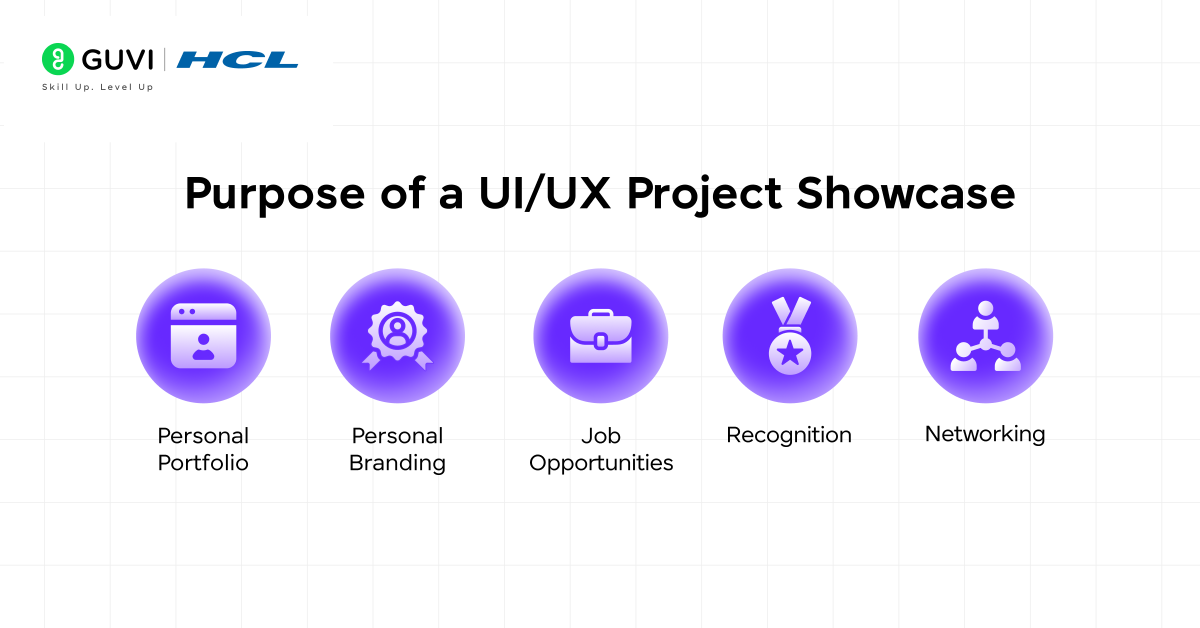
7 Essential Things to Make Your UI/UX Project Showcase Stand-out
Jul 04, 2025 4 Min Read 5174 Views
(Last Updated)
UI/UX project showcase is a mandatory thing that every designer should have. Are you confused about how to create your project showcase? Worry not, we’ve got you covered!
In this blog, we will see the 7 essential things to make your UI/UX project showcase stand out from others. To make you understand better, we will start with defining the purpose of a showcase and how it is affecting a designer’s career, followed by the essential things, and a few examples of showcases from top designers. Let’s get started!
Table of contents
- Purpose of a UI/UX Project Showcase
- 7 Essential Things to Make Your UI/UX Project Showcase Stand Out
- Tell a Complete Story
- Highlight the Problem and Your Solution to it
- Showcase Your Research
- Demonstrate Your Design Process
- Polish the Design
- Show Real Impact
- Make it Personal
- UI/UX Project Showcases Examples
- Danna Shapiro
- Randon Sommars
- Celia Hazard
- Daniel Autry
- Gloria Lo
- Conclusion
- FAQ
- What is UI and UX?
- What is a UI/UX project showcase?
- Where can I showcase my UI/UX projects?
- Can I include personal projects in my UI/UX project showcase?
- How do I ensure my UI/UX project showcase stands out?
Purpose of a UI/UX Project Showcase

The purpose of a project showcase plays a crucial role in a designer’s career. A project showcase acts as a personal portfolio of each designer whether they are a noob or a pro. This is the best way to showcase your skillsets, knowledge on design, and previous designs to motivate others and make you present neatly to other people. Let’s look into a few reasons for having a UI/UX project showcase in detail.
- Personal Portfolio: As a designer, having a personal portfolio in the form of UI/UX portfolios shows professionalism and seriousness towards your career. This will demonstrate your skillset, projects, education, and case studies you have done so far.
- Personal Branding: This project showcase will be a great source for your branding. It communicates your style, expertise, and types of projects you excel in and makes you stand out from the crowd.
- Job Opportunities: Having a strong project showcase will help you attract hiring managers who look for designers with the same skillset as yours.
- Recognition: Publishing your designs on platforms such as Dribble, Figma, or Behance will attract a lot of people and will gain you recognition from others.
- Networking: These showcases might introduce you to a wide range of designer communities around the world and present you with various opportunities.
7 Essential Things to Make Your UI/UX Project Showcase Stand Out
Creating a strong UI/UX project is only halfway; how you present it can make or break your chances of impressing your potential collaborators, recruiters, or clients. In this section, we will look into the 7 essential things for your UI/UX project showcase to stand out.

Tell a Complete Story
A successful UI/UX design is more than just visuals. Tell your audience the entire story and walk through the journey with your designs from the problem you were solving to how your design made a difference. Think of your design solution as storytelling with a purpose.
Highlight the Problem and Your Solution to it
Start your design with a clear, concise explanation of the problem you tackled. This sets the stage and gives context for your solution. Then, showcase how your design decisions were able to solve the user’s needs or business goals. This helps to demonstrate your critical thinking and problem-solving skills.
Showcase Your Research
Include your research on the problem you are tackling, which includes user interviews, personas, competitive analysis, or usability testing that demonstrates a human-centered and data-driven approach.
Demonstrate Your Design Process
Break down your process into key stages like wireframes, user flows, prototypes, and UI design. Use visuals to walk people through the evolution of your work. Annotated screens or design rationale can help viewers understand why things look the way they do.
Polish the Design
First impressions matter. Use high-quality images, maintain consistent spacing, and ensure everything is easy to scan. A messy presentation can undermine even the best design. Tools like Figma, Notion, or Webflow can help keep things clean and professional.
Show Real Impact
Did your design increase conversions, reduce drop-off rates, or make life easier for users? Include metrics, quotes from users, or client testimonials if available. This brings credibility and shows the real-world value of your work.
Make it Personal
Your showcase should reflect your personality, your strengths, and your design philosophy. Don’t be afraid to inject your voice into your writing or include passion projects that show what excites you as a designer.
Are you confused in getting started with your UI/UX journey? Don’t worry, take your first step towards your goal with Guvi’s FREE E-book on First Steps in UI/UX: Your Beginner’s Guide to Design Excellence.
UI/UX Project Showcases Examples
1. Danna Shapiro
Danna’s portfolio reflects her rich background in both the arts and design, and it’s a great example of how to bring different types of creative work together in one cohesive space. Her strong visual sense shines through—from her fun, engaging landing page to her standout branding projects. What really sets her apart, though, is how she blends that creativity with a deep understanding of users and an empathetic design approach. Her work leaves an impression.
2. Randon Sommars
Randon’s projects catch the eye with bold, well-crafted UI. He knows how to use color and branding to elevate the user experience, and it shows throughout his work. His portfolio strikes a great balance—he’s got a strong visual identity as a designer, but also backs it up with solid UX thinking and thorough research. The result? Projects that are not only beautiful but also deeply thoughtful.
Kickstart your UI/UX journey by enrolling in GUVI’s UI/UX Course, where you will master technologies like Adobe XD, Illustrator, and Figma, and build interesting real-life UI/UX projects.
3. Celia Hazard
Celia brings a fresh, unconventional vibe to how she presents her UX work. She refers to herself as a “design scientist,” and you can see how deeply research informs everything she does. Her case studies are bold yet thoughtfully structured—detailed enough to show depth, but still easy to follow. Overall, her portfolio stands out with a unique and refreshing take on UX design.
4. Daniel Autry
Daniel Autry, a designer and developer based in Charlottesville, Virginia, reminds us that there’s no one-size-fits-all when it comes to portfolio projects. His work shows that it’s not about how many projects you include, but how well they reflect your unique approach and strengths as a designer. It’s a great example of making your portfolio truly your own.
5. Gloria Lo
Gloria’s portfolio kicks off with a beautifully crafted, three-part introduction that immediately pulls you in. She leads with a bold, catchy headline that captures her personality through four simple, action-packed verbs—each hinting at her creativity, versatility, and wide range of interests. And as a fun, interactive detail, those verbs change color when you hover over them, adding a layer of playfulness and polish.
Her approach is a great reminder: start your UX portfolio with a strong, memorable intro on the homepage, then use a dedicated “About” section to dive deeper into your story. Keep it short, but make it count.
Conclusion
In conclusion, UI/UX project showcases play a pivotal role in the world of design and development. These showcases serve as powerful tools for designers to demonstrate their skills, creativity, and problem-solving abilities. By consistently striving to create an engaging and informative UI/UX project showcase, you can leave a lasting impression and continue pushing the boundaries of design innovation and user-centric solutions.
FAQ
UI stands for User Interface, which focuses on the visual design and presentation of digital products to enhance user interactions.
UX stands for User Experience, which encompasses the overall experience users have while interacting with a product, considering usability, accessibility, and satisfaction.
A UI/UX project showcase is a collection of completed design projects that demonstrate a designer’s or developer’s skills and expertise in creating user-centered digital experiences.
It typically includes visual designs, wireframes, prototypes, and detailed explanations of the design process.
Popular platforms to showcase UI/UX projects include Behance, Dribble, and personal portfolio websites.
LinkedIn and other professional networking sites are also excellent places to share your projects with potential employers and clients.
Yes, personal projects can be included in your showcase. They demonstrate initiative, passion, and your ability to work on projects independently.
Focus on presenting your projects with high-quality visuals and clear explanations of your design decisions.
Showcase a variety of projects to demonstrate your versatility as a designer.
Incorporate case studies to highlight your problem-solving approach and the impact of your design decisions.



















Did you enjoy this article?